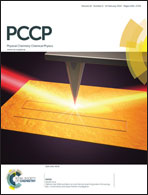Complex diffusion behavior of oxygen in nanocrystalline BaTiO3 ceramics†
Abstract
18O/16O exchange annealing and subsequent Time-of-Flight Secondary Ion Mass Spectrometry (ToF-SIMS) analysis is used to investigate oxygen transport in dense, nanocrystalline (average grain size d ≈ 300 nm) ceramics of nominally un-doped BaTiO3. Isotope penetration profiles are obtained as a function of temperature, 973 < T/K < 1173, at an oxygen activity aO2 = 0.20 and as a function of oxygen activity, 0.002 < aO2 < 0.20, at T = 1073 K. All isotope profiles show the same unusual shape: a flattened profile over the first ∼102 nm, followed by a short, conventional diffusion profile. We demonstrate that the entire isotope profile can be described quantitatively by a numerical solution to the diffusion equation based on an increase in the local oxygen diffusion coefficient close to the surface. This position-dependent increase is attributed to additional oxygen vacancies that are generated by diffusion of chlorine impurities out of the ceramics. The presence of chlorine derives from the chemical route necessary to produce nanometric powders: it thus indicates a new manner in which nanocrystalline ceramics may differ from their microcrystalline counterparts.


 Please wait while we load your content...
Please wait while we load your content...